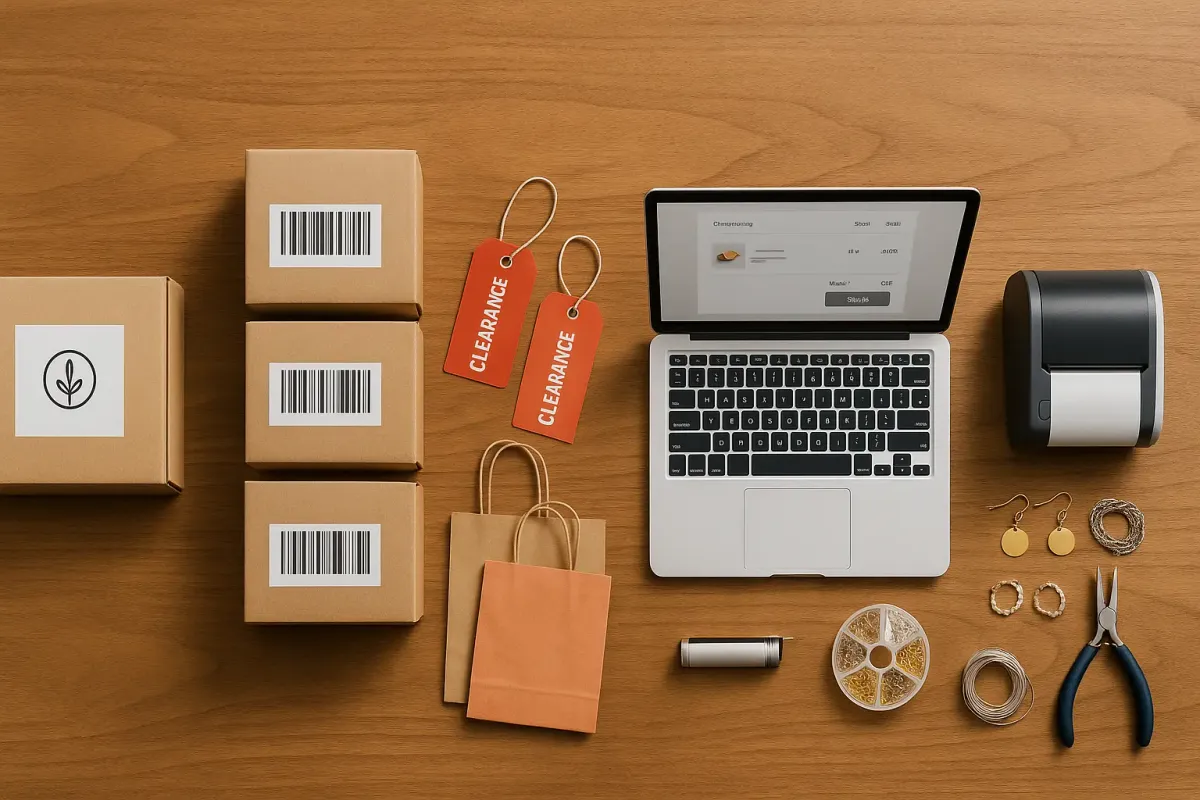What Are the Different Types of Selling Models on Amazon?

Amazon offers different types of selling models that you can use, including private label, wholesale, arbitrage, dropshipping, and handmade. Each model has its own pros, costs, and strategies.
If you're thinking about selling on Amazon, one of the first things to figure out is how you want to run your business. Some sellers build their own brands. Others resell popular products. Some never handle inventory at all.
It might seem like a lot, but don't worry—this guide breaks down each selling model in a simple, clear way. Whether you're just exploring or ready to start, you'll walk away with a solid understanding of your options.
Let’s get into it.
Key Takeaways:
- Amazon has different selling models ranging from low-cost arbitrage to higher-investment private label businesses.
- Each model has different startup costs, profit potential, and time requirements that suit different seller goals.
- You can compare costs, profits, and complexity across all models to choose the best fit for your budget and experience level.
What Is Private Label Selling on Amazon?

Private label means creating your own branded product and selling it on Amazon under your brand name.
You work with a manufacturer to produce the product, then list and sell it through your own Amazon store.
This is the most popular way to sell on Amazon—used by about 54% of sellers. It gives you full control over pricing, packaging, and marketing.
How It Works:
- Find a product with strong demand and low competition
- Hire a manufacturer to make it with your branding
- Create a product listing on Amazon
- Use Amazon FBA to store, ship, and handle returns
Major Benefits:
| Benefit | Why It Matters |
|---|---|
| High profit margins | You buy from factories at low cost and set your own prices |
| Brand control | You choose how your product looks, feels, and sells |
| Easy to scale | You can grow by adding more products under your brand |
Key Drawbacks:
- You need money upfront for inventory
- Product research takes time
- There’s risk if your product doesn’t sell or has quality issues
Best For:
This model works best if you want to build a long-term business. You’ll need patience, money, and time—but it offers more control and higher profits than other Amazon methods.
What Is Wholesale Selling on Amazon?

Wholesale selling means you buy branded products in bulk from suppliers and resell them on Amazon for a profit.
You don’t need to create your own brand—you sell items people already know and trust.
About 47% of wholesale sellers started with less than $2,500. Many earn over $5,000/month, but profit margins are often lower due to heavy competition.
How It Works:
- Contact brand owners, manufacturers, or authorized distributors
- Buy large quantities of products at wholesale prices
- List those products on Amazon and sell them individually
- Use Amazon FBA or ship items yourself
Major Benefits:
| Benefit | Why It Helps |
|---|---|
| Well-known brands | Shoppers already trust these products |
| No branding needed | You don’t need to design or market a new product |
| Pre-made listings | Many products already exist on Amazon—just add your offer |
Key Drawbacks:
- You must apply to become an approved reseller
- You’ll need to build relationships with suppliers
- Prices may drop if too many sellers offer the same item
Best For:
Wholesale works best for people who want to sell trusted products without building a brand. It’s a good fit if you prefer systems and suppliers over product creation.
What Is Arbitrage on Amazon?

Arbitrage is when you buy discounted products from stores or websites and resell them on Amazon for a profit.
You find products that cost less elsewhere—like Walmart, Target, or eBay—and list them on Amazon at a higher price.
- Retail Arbitrage – You visit physical stores to find deals
- Online Arbitrage – You find deals from online marketplaces and shop from home
Both use the same strategy: buy low, sell high.
How It Works:
- Look for discounted products in stores or online
- Check Amazon prices to find profitable items
- Buy products and list them on Amazon
- Ship items yourself or use Amazon FBA
Major Benefits:
| Benefit | Why It Helps |
|---|---|
| Low startup costs | You can start with just a few items and a small budget |
| Fast learning curve | Great way to understand Amazon’s system quickly |
| Low risk | You don’t need to invest in branding or bulk inventory |
Key Drawbacks:
- Finding good deals takes time and research
- It's hard to scale into a large business
- Profit margins are often low due to fees and competition
- Retail stores may limit how many items you can buy
Best For:
Arbitrage is best for beginners who want to learn by doing. If you like deal hunting, don’t mind a little hustle, and want a low-cost way to start selling on Amazon, this model is a great entry point.
What Is Dropshipping on Amazon?

Dropshipping lets you sell products on Amazon without keeping any inventory.
You list items for sale, and when a customer places an order, you buy the product from a supplier. The supplier ships it directly to the customer—no storage or shipping on your end.
This model has lower upfront costs but comes with tighter margins and stricter Amazon rules.
How It Works:
- List products on Amazon (you don’t own them yet)
- Customer places an order
- You buy the item from a third-party supplier
- Supplier ships directly to the customer
You’re the middleman, handling the sale but not the product.
Major Benefits:
| Benefit | Why It Helps |
|---|---|
| No inventory needed | You don’t have to store, pack, or ship products |
| Low startup costs | No need to buy products upfront |
| Lower risk | You only pay for items after you make a sale |
Key Drawbacks:
- Strict Amazon rules – You must follow their policies exactly
- Limited control – You can’t check product quality before shipping
- Slow shipping – Delivery speed depends entirely on your supplier
- Thin margins – Profit per sale is often lower than other models
Best For:
Dropshipping works best for sellers who want a low-cost entry point and don’t mind giving up some control. It’s ideal if you’re comfortable with lower profits and willing to manage supplier relationships carefully.
Just be sure to follow Amazon’s dropshipping policies closely—violations can get your account suspended.
What Is Handmade Selling on Amazon?

Handmade selling means offering handcrafted, custom-made products through the Amazon Handmade marketplace.
You apply and get approved as an artisan, then list your handmade goods in a special section of Amazon built for creators.
Unlike mass-produced items, these products are made by you (or your team), often one at a time or in small batches.
It’s Amazon’s version of Etsy — ideal for artists, crafters, and makers who want exposure on a bigger platform.
How It Works:
- Apply to Amazon Handmade and get approved as an artisan
- Create product listings (no UPCs or GTINs required)
- List items in handmade-specific categories
- Use Fulfilled by Merchant (FBM) or Amazon FBA (with limitations)
Major Benefits:
| Benefit | Why It Matters |
|---|---|
| Low competition | Fewer sellers offer handmade goods, so you stand out more easily |
| No UPC/barcodes required | Easier listing process for unique, one-off products |
| Built-in audience | Amazon Handmade attracts customers specifically looking for artisanal products |
Key Drawbacks:
- You must apply and get approved by Amazon
- Limited access to Amazon marketing and ad tools
- Fulfillment options are more restricted (FBA allowed only for certain items)
- Harder to scale since items are often made one by one
Best For:
This model is perfect for artisans, crafters, and small makers who want to reach a wider audience while keeping their products unique. If you already sell on Etsy or at craft fairs, Amazon Handmade is a great way to expand without losing your personal touch.
Comparison Table: Side-by-Side Breakdown
Each Amazon business model comes with different startup costs, inventory, requirement, risks, and profit potential. Use this quick comparison to see which one fits your goals and resources.
| Selling Model | Startup Cost | Inventory Required | Risk Level | Profit Potential |
|---|---|---|---|---|
| Private Label | High | Yes | Medium | High |
| Wholesale | Medium–High | Yes | Medium | Medium–High |
| Arbitrage | Low | Yes (small qty) | Medium | Low–Medium |
| Dropshipping | Low | No | High | Low–Medium |
| Handmade | Low | Yes (custom) | Low | Medium |
Final Thoughts: Which Amazon Selling Model Should You Choose?

There’s no single “best” way to sell on Amazon—only the one that fits you. Each model has pros and cons depending on your budget, time, and goals.
Here’s a quick reminder:
- Private Label is best if you want to build a brand and can invest upfront.
- Retail Arbitrage is great for fast starters with low capital.
- Online Arbitrage offers more flexibility without store visits.
- Wholesale works well if you want steady supply and proven products.
- Dropshipping is low-cost but higher risk.
- Handmade suits creatives selling unique, handcrafted items.
Many successful sellers start with one model (like arbitrage) and shift to others (like private label) as they gain experience and capital. You don’t have to stick with one forever—Amazon lets you pivot as your business evolves.
Key Questions to Ask Yourself
- How much money can I invest upfront?
- How much time can I commit each week?
- Do I want to build a brand or just flip products?
- Am I in this for a side hustle or long-term growth?
Frequently Asked Questions

1. Which Amazon selling model is best for beginners?
Retail arbitrage is the easiest way to start. You can begin with under $500 and start selling within a few weeks. It’s simple: find discounted items at stores like Walmart or Target, then resell them on Amazon for profit.
2. Can I try more than one selling model?
Yes, many sellers use multiple models. You might start with retail arbitrage to learn the system, then shift to private label or wholesale as you grow. Combining methods is common and can diversify your income.
3. Is dropshipping allowed on Amazon?
Amazon allows dropshipping, but only under strict rules. You must:
- Be the seller of record on all invoices
- Ship orders without third-party branding or receipts
You can’t buy from other retailers and ship directly to customers. Violating these rules can get your account suspended.
4. Do I need an LLC or business license to sell?
No, you can sell as an individual. Amazon doesn’t require an LLC or business license to start. But forming a legal business later helps with taxes and liability. Always check your local laws and tax rules.
5. What’s the most profitable Amazon selling model?
Private label has the highest profit potential. Around 56% of private label sellers earn over $5,000 per month.
Wholesale also performs well, with 61% of sellers hitting the same milestone. Both require more upfront investment than arbitrage or dropshipping, but offer greater long-term returns.
6. Which model is best for passive income?
Private label offers the best potential for passive income. Once your product is launched and fulfilled through FBA, Amazon handles storage, shipping, and returns. Just know it takes upfront money and research to get there.
7. Is handmade selling part of the regular Amazon marketplace?
No, handmade products are sold through Amazon Handmade. It’s a separate, curated section that requires approval. Only handcrafted goods made by you or your small team are allowed.
8. Can I use FBA with all these models?
FBA works with most models—except dropshipping. You can use FBA with private label, wholesale, arbitrage, and handmade (if approved). Dropshipping isn’t compatible because you never handle the inventory yourself.
9. What’s the cheapest way to start selling on Amazon?
Retail or online arbitrage is the lowest-cost option. You can start with under $500 by buying discounted products and flipping them on Amazon. It's beginner-friendly, but requires time and consistent sourcing.
10. Which model gives you the most control over your brand?
Private label gives you full brand control. You decide the product design, packaging, pricing, and messaging. It’s ideal for building a long-term brand that stands out on Amazon.
Ready to Start Selling on Amazon—But Not Sure Which Model Fits You Best?
Join our beginner-friendly mini-course at WAH Academy and get clear on how private label, wholesale, arbitrage, dropshipping, and handmade really work—so you can choose the one that fits your budget, lifestyle, and goals.
No fluff. No guesswork. Just step-by-step guidance to help you start smart.
Tap below to take the first step toward your Amazon business.
